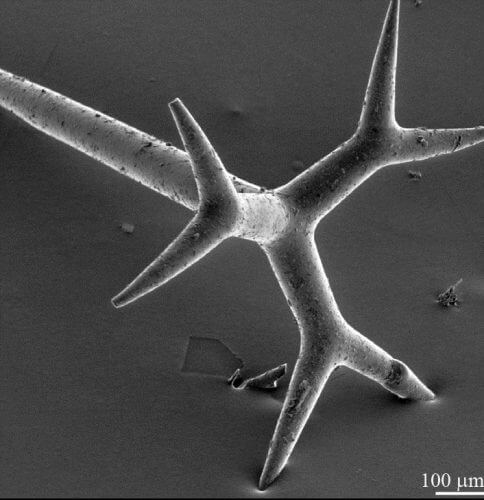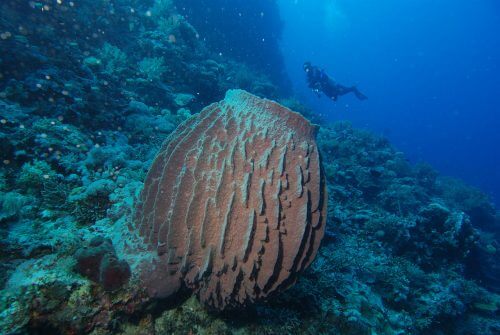Researchers from the Technion and Germany deciphered the formation process of the glass needles of the sea sponges. The discovery reveals the principle that enables the natural production of glass without heating

Sponges ("sea sponges") are the oldest and most primitive multicellular organisms - their origins more than half a billion years ago. These creatures live mainly in salt water and feed on particles of organic matter. Despite their simplicity, several families of sponges developed during evolution the ability to synthesize glass needles - unique and precise structural elements that provide the sponge with structural support, mechanical strength and protection against hostile factors. The needle (spicule) is made of formic oxide (silica) and is between a few microns and several millimeters long. These needles form as three-dimensional branched structures, which are an example of symmetry in biological systems (Figure 1).
The creation of the glass needles by the sponge is completely different from artificial processes of glass processing, which require heating the material to about 1,000 degrees Celsius. The natural mechanism of the creation of the glass needles at the temperature of sea water has now been revealed for the first time in an article written by Prof. Emeritus Emil Zolotoyavko from the Faculty of Materials Science and Engineering at the Technion together with his partners in Germany, led by Dr. Igor Zlotnikov from the Technical University in Dresden. The research, published in the journal Science Advances, presents the principle of building the glass needles in silica sponges (Demospongiae) - the largest group in the sponge system. Decoding the structure of the needle is based on experiments conducted at the ESRF - the European Electron Accelerator in Grenoble, France. These experiments were carried out using X-rays using the most advanced methods: nanotomography and diffraction under a focused beam.
The researchers discovered that the glass needle is built around an organic fiber about 3 microns in diameter. This fiber is mainly made of silicateins - enzymatically active proteins that accelerate the growth of nitric oxide. This process is controlled by specialized cells called sclerotocytes (skeleton building cells).

A particularly interesting discovery concerns the arrangement of the proteins in the fiber. The proteins are organized in nanometer blocks arranged in a unique periodic structure: a crystal-like hexagon. The pores within this structure are filled with amorphous silica. According to Prof. Zolotoyavko, "The nanometer blocks of protein and amorphous silica are built in a cyclic order that creates very sharp points in the X-ray diffraction pattern (photo 2). This pattern provides comprehensive information about the symmetry and the process of folding the needles."
Among other things, the researchers discovered that "the main stem of the needle grows perpendicular to the basic plane of the protein's hexagonal lattice, and the spikes that grow to the sides are guided by pyramidal planes that are at an angle of about 66 degrees relative to the basic plane. This is how the shape of a tetrapod is obtained - a meeting between four spines. We also found additional planes that are responsible for the formation of fork-like branches (photo 1)."

According to Prof. Zolotoyavko, "From an engineering point of view, there is a fascinating process in which nature creates, from available materials, extremely complex glass structures at low temperatures - a process that man has not yet been able to realize. We estimate that our research, which deciphers the formation mechanism of the branched glass needles in sponges, may provide inspiration for production processes of useful nanocrystalline materials without the need for heating to high temperatures."

One response
What is the enthusiasm here for the process of preparing silica and oxides of other transition metals without heating to thousands of degrees? After all, already from the middle of the 19th century (in 1846, I think) a chemical process of the SN2 type called the "Sol-Gel" process, which takes place at room temperature, and which was revived and re-evaluated in the 1980's, was published in the world scientific literature Prof. David Avnir from the Hebrew University of Jerusalem. Today, there is almost no company (manufacturing extremely high-definition monitors, hydrophobic windshields for cars, dust-repellent coatings, "smart" windows, a huge variety of colored coatings consisting of trapped organic substances, countless sensors, pH electrodes (called "glass electrodes"), And more and more. Beyond that, already in the 90s of the twentieth century, more and more marine animals began to be discovered that create a silica mantle around them. So what's new here?!?
And in the same breath: it is a shame that the researchers who published this article did not cite a single publication from Prof. Avnir in understanding the sol-gel process and its accelerated development. In short - there is nothing new under the sun, or as my late grandfather used to say: "There is nothing new under the sun".